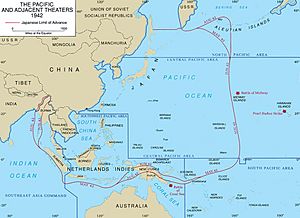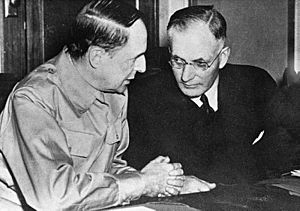South West Pacific Area facts for kids
Quick facts for kids South West Pacific Area |
|
|---|---|
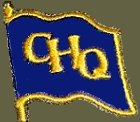
South West Pacific Area shoulder sleeve insignia
|
|
| Active | 1942–45 |
| Country | |
| Anniversaries | 30 March 1942 |
| Engagements | World War II
|
| Disbanded | 2 September 1945 |
| Commanders | |
| Notable commanders |
Douglas MacArthur |
The South West Pacific Area (SWPA) was a very important military command during World War II. It was set up by the Allied countries. This command covered a huge area in the Pacific War, including places like the Philippines, Borneo, Dutch East Indies (Indonesia), East Timor, Australia, and parts of New Guinea and the Solomon Islands.
Most of the soldiers and sailors in SWPA were from the United States and Australia. But forces from the Netherlands, the Philippines, and the United Kingdom also served there.
General Douglas MacArthur was the top commander of the South West Pacific Area. He was given this job on April 18, 1942. He created five main groups under his command. These included groups for land, air, and naval forces. There were also groups for US Army forces in Australia and the Philippines. The Philippines group disappeared when the island of Corregidor was taken by the enemy in May 1942. The other main groups stayed until SWPA was closed down on September 2, 1945.
Contents
How the Command Started
Before SWPA, there was a command called the American-British-Dutch-Australian Command (ABDA). This command was active for a short time in late 1941 and early 1942. The Japanese forces moved very quickly through the Dutch East Indies. This split the ABDA area in two. So, in February 1942, the ABDA command was ended.
Another important group was formed when a supply convoy for the Philippines was sent to Australia instead. This happened after the attack on Pearl Harbor. On December 12, 1941, Brigadier General Julian F. Barnes was put in charge of these troops in Australia. This group was first called United States Forces in Australia (USFIA). Later, it was renamed U.S. Army Forces in Australia (USAFIA) in January 1942. Its main job was to create a supply base in Australia to help the forces still fighting in the Philippines.
Leaders from Australia and New Zealand met in Melbourne in early 1942. They suggested creating a new war zone that would include Australia and New Zealand. They thought Lieutenant General George Brett should lead it. Brett was already in charge of the US Army Forces in Australia.
The leaders of the United States and the United Kingdom also talked about how to manage the war in the Pacific. They decided that the United States would be in charge of the Pacific area. An American commander would lead all forces there. Australia and New Zealand agreed but wanted to have a say in the overall war plans.
This led to the creation of the Pacific War Council. It met in London and Washington, D.C. This council allowed countries like Australia and New Zealand to share their concerns with the US President. However, it did not have much power over the actual war strategy.
Setting Up the SWPA Command
General Douglas MacArthur was the clear choice to be the top commander in the Pacific. He had been told to leave the Philippines and go to Australia to take command. He had strong support from the US President and the Army. However, the US Navy was not as keen on an Army officer leading naval operations.
The US military leaders discussed how to divide the Pacific. They decided to split it into three main areas. On March 30, 1942, these areas were officially named:
- The Pacific Ocean Areas (POA), led by Admiral Chester Nimitz.
- The Southwest Pacific Area (SWPA), led by General MacArthur.
- The Southeast Pacific Area, which did not become a very active war zone.
The Australian Prime Minister, John Curtin, told all Australian defense forces to follow MacArthur's orders. However, some Australian military groups, like army workshops and air force training, stayed under Australian control. The Australian government also wanted to be asked before MacArthur moved Australian troops outside of Australia. This was important because of rules about where Australian soldiers could serve.
MacArthur's Headquarters
MacArthur became the Supreme Commander of SWPA on April 18, 1942. He preferred to be called "Commander in Chief." He quickly set up his main staff, called General Headquarters (GHQ). His Chief of Staff was Major General Richard K. Sutherland. Most of MacArthur's staff were US Army officers who had worked with him before.
In July, MacArthur moved his GHQ from Melbourne to Brisbane. It was located in the AMP Building. The headquarters for the Allied Air Forces and Allied Naval Forces were also in the same building. Later, the Advanced GHQ moved closer to the fighting, first to Hollandia in 1944, then to Leyte and Manila in the Philippines.
In April 1945, there was a big change for the planned invasion of Japan. All US Army forces in the Pacific were placed under MacArthur's command. A new command, Army Forces Pacific (AFPAC), was formed. GHQ then served as the headquarters for both AFPAC and SWPA. SWPA was officially closed on September 2, 1945. But GHQ continued as GHQ AFPAC.
Allied Land Forces
General Sir Thomas Blamey, who was the head of the Australian Army, became the Commander of Allied Land Forces in SWPA. His headquarters was called LHQ. An Australian commander was chosen because most of the land troops were Australian. In April 1942, there were 38,000 American ground troops and 369,000 Australian troops in SWPA.
When MacArthur's main headquarters moved to Brisbane, Blamey's LHQ stayed in Melbourne. But Blamey set up an Advanced LHQ closer to the action.
MacArthur often controlled land operations directly through special "task forces." These forces reported straight to his GHQ. The most important of these was the New Guinea Force. General Blamey himself commanded this force at times. In February 1943, the Sixth United States Army arrived. Its headquarters became Alamo Force, which also reported directly to MacArthur. This meant Blamey did not command most of the American land forces after that time.
In 1944, MacArthur planned to take direct command of land forces when they reached the Philippines. He suggested Blamey could either go with him or stay in Australia. By September 1944, several US and Australian armies and corps reported directly to MacArthur's GHQ. Allied Land Forces continued as an important group for managing supplies and administration. It was closed down with SWPA on September 2, 1945.
Allied Air Forces
The Allied Air Forces were created under Lieutenant General George Brett. Brett tried to combine the US and Australian air forces very closely. He had an Australian officer, Air Vice Marshal William Bostock, as his chief of staff. US and Australian officers worked together in many roles.
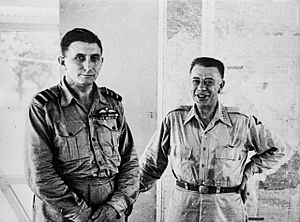
However, there were disagreements between Brett and MacArthur. Also, US leaders were worried about how Brett was mixing the US and Australian air forces. So, in July 1942, MacArthur replaced Brett with Major General George Kenney.
Kenney made many changes. He sent home several senior officers and brought in new, talented leaders like Ennis Whitehead and Kenneth Walker. Kenney also started to separate the US and Australian air forces again. He appointed Air Vice Marshal Bostock to lead the newly created RAAF Command.
Kenney also created new ways to manage air operations. He set up the Advanced Echelon (ADVON) to quickly change aircraft assignments in battle areas. He also created Air Task Forces for specific missions. These ideas were new and helped the air forces react faster to changing situations.
Later, the Thirteenth Air Force and the Seventh Air Force were added to the Allied Air Forces. The RAAF also formed its own Australian First Tactical Air Force. Allied Air Forces was closed on September 2, 1945.
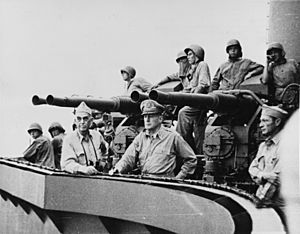
Vice Admiral Herbert F. Leary was chosen to lead the Allied Naval Forces in April 1942. He was also in charge of the Southwest Pacific Force. The most important group under his command was the Anzac Squadron, which included ships from Australia and the UK.
In September 1942, Leary was replaced by Vice Admiral Arthur S. Carpender. Like Leary, Carpender reported to MacArthur for Allied Naval Forces duties. The head of the Royal Australian Navy and the Royal Netherlands Navy were actually senior to Carpender. But they agreed to serve under him.
The Southwest Pacific Force was renamed the Seventh Fleet in March 1943. Its groups were renumbered to match. An important part of the Seventh Fleet was the VII Amphibious Force, which was in charge of landing troops from ships. This force grew as more landing craft and ships arrived.
MacArthur did not get along well with Carpender. He asked for Carpender to be replaced twice. In November 1943, Vice Admiral Thomas C. Kinkaid took over. During the Battle of Leyte Gulf, there were some problems between Kinkaid and another US Admiral. This showed how difficult it could be when commands were split. Allied Naval Forces was closed on September 2, 1945.
Supply and Support
The U.S. Army Forces in Australia (USAFIA) built many bases in Australia. These bases were meant to support US forces. Seven main base sections were set up across Australia. On July 20, 1942, USAFIA became the United States Army Services of Supply, Southwest Pacific Area (USASOS SWPA).
When the Sixth United States Army arrived in Australia in February 1943, some of the supply jobs were given to a new headquarters called United States Army Forces in the Far East (USAFFE). This left USASOS to focus only on logistics, which means getting supplies and equipment where they needed to go.
As the Allied forces moved forward, new bases were opened closer to the fighting. Old bases in Australia were closed down. For example, bases were opened in Port Moresby and other parts of New Guinea. Later, many bases were opened in the Philippines.
Because of the long distances and lack of good transport, getting supplies by water was very important. The SWPA command had its own large fleet of ships. This "Permanent Local Fleet" grew to almost 100 large ships by 1945. It also had many smaller vessels like landing craft and barges. These ships were crucial for moving troops and supplies across the vast Pacific area.
On June 7, 1945, USASOS became AFWESPAC. It took over USAFFE's duties.
Intelligence Gathering
In April 1942, US and Australian intelligence leaders decided to combine their efforts. They created a group called the Central Bureau. This group included people from the Australian, British, and US Armies, as well as their air forces and navies. Their main job was to break codes and read secret Japanese messages. This "Magic" and "Ultra" intelligence was very important for Allied operations in SWPA.
To gather other types of information, General Blamey and General MacArthur created the Allied Intelligence Bureau (AIB). This group included:
- The Services Reconnaissance Department, which carried out special secret missions.
- The Coastwatchers, who watched for Japanese planes and ships from behind enemy lines.
- The Far Eastern Liaison Office (FELO), which created propaganda.
Two other important groups were the Allied Translator and Interpreter Section (ATIS), which translated Japanese documents, and the Allied Geographical Section, which made maps and studied the land.
Working together on intelligence was very successful. It helped the Allies avoid mistakes and win battles. This cooperation also created a strong bond between the intelligence services of Australia, New Zealand, and the United States. This bond has continued to be important even after World War II.
What We Learned
The way the Allied forces worked together in the South West Pacific Area had its challenges. But the benefits of these alliances were huge. It took constant effort to keep everyone working together smoothly. For Australia and New Zealand, fighting alongside other countries became a normal part of their military. The experiences in SWPA taught them many important lessons about politics and military cooperation.
In the years that followed, Australian, New Zealand, and American forces fought together again. They teamed up in wars like the Korean War, the Vietnam War, and the War on Terror.


